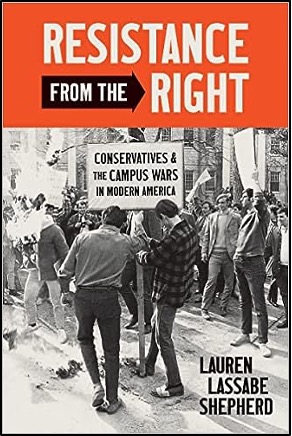Philanthropy
Philanthropy and the Campus Wars—and Later, the Larger Culture War—in Resistance from the Right
Lauren Lassabe Shepherd’s new book on the “campus wars” can credit philanthropically supported conservative groups only for throwing “sand into the gears of the machines that drive the academy’s democratic mission.” She finds other, positive effects of this philanthropic support for conservatism—off-campus and decades later.


“Conservatives did not win the campus wars of the 1960s, and they failed in almost every way to meaningfully pull faculty and students to the right during their time on campus,” historian Lauren Lassabe Shepherd concludes in her new book Resistance from the Right: Conservatives and the Campus Wars in Modern America.
This is correct, and its correctness need be part of any honest evaluation of the effectiveness of the conservative philanthropy that helped support the many nonprofit organizations seeking to win those “campus wars,” of course.
“Yet their counteractivism has by design thrown sand into the gears of the machines that drive the academy’s democratic mission, then and now,” continues Shepherd, an instructor of higher education at the University of New Orleans.
There are two notable, explicit, underlying assumptions there. First, that the academy’s mission is democratic—and not the articulation, credentialization, and implementation of an elite progressivism, as conservatives and conservative philanthropy might have perceived and still perceive it.
The second assumption is that either the or a purpose of conservative “campus-war” giving was—”by design”—merely to “throw sand into the gears” of progressive higher education and “the machines that drive” its mission and not to win the “wars.”
I’m genuinely curious about whether that’s necessarily the case. As a program officer for almost two decades at a foundation involved in subsequent higher-ed funding, it seems likely to me that most grant proposals from conservative campus groups were leading their readers to believe that on-campus “victory” was the goal, on whatever particular timeline and budget and with whomever leading the charge.
If mere “sand in the gears” was always the more-realistic and -achievable aim, well, then that too would be relevant to any honest evaluation of the effectiveness of all the conservative philanthropic support given to groups in and related to the campus wars. It’s not the same thing as winning, or it at least defines victory quite differently. If understating the purpose of most conservative higher-ed philanthropy—maybe holding it to a lesser standard than even its own—Shepherd’s Resistance from the Right may overstate its case.
Donors and Design
“The Right’s campus mobilization” in the late 1960s “was less an organic youth endeavor than a top-down directive from funding giants in the larger movement, primarily leaders associated with the Foundation for Economic Education, the Mont Pelerin Society, and writers at National Review, Modern Age, Human Events, Commentary, and Public Interest magazines,” according to Shepherd.
“Major benefactors included Harold Luhnow of the William Volker Fund, businessman Charles Koch, former New Jersey governor Charles Edison, banking and oil magnate Richard Mellon Scaife, philanthropist Henry Salvatori, and others connected through direct mail operations by fundraisers Marvin Liebman and Richard Viguerie,” she continues. For subsequent higher-ed grantmaking, the book later mentions The Lynde and Harry Bradley Foundation, where I worked.
The major donation-receiving groups profiled and critiqued in Resistance from the Right include “old standbys” like: Campus Crusade for Christ International; the Intercollegiate Studies Institute (ISI), originally called the Intercollegiate Society of Individualists; and Young Americans for Freedom (YAF), since renamed but retaining the familiar YAF acronym.
“What bound them together through the Vietnam War and civil rights era, they claimed, was anticommunism,” Shepherd writes. “What they were actually united by was something much less sinister: liberalism.”
They “participated in an astroturf mobilization against a so-called liberal establishment in higher education during their time on campus—an era typically associated with the New Left antiwar and Black Power student movements,” according to Shepherd. The outcome: sand in the gears, as she puts it. By design.
An (After-)Effect
But an effect, as Shepherd sees it: afterwards, they then “became known as the New Right in the 1970s” and “used the skills they learned in college to consciously drive American politics and culture further to the authoritarian right, with the Republican Party as their vehicle.”
Those skills were borne of “the student Right’s relative weakness in comparison to the student Left,” which “ironically became an efficiency once these young people understood that they did not need to be popular to wield power,” she writes. They just needed to “tap[] into existing channels of authority,” for which “winning over their peers was not necessary to achieve their desired ends.
“This understanding was formative in developing the new Right’s organizing techniques, not just during their time on campus but for the rest their careers as the next generation of movement leaders,” Shepherd notes. “The New Right’s coalition of former YAFers, College Republicans, and ISI students have gone on to found think tanks, operate and fundraise through political action committees, and exercise their organizational talents to bring new constituents, including the religious Right, into the Republican Party.”
The sand-in-the-gear skills that conservatives developed in losing the campus wars, in other words, helped them win battles in the later, larger culture war against liberalism. And that’s quite plausible—in fact, probably true.
Mythical Memo
But if Shepherd means to argue that this indirect, wider benefit of higher-ed giving was by the purposeful design of donors, too, its evidence is wanting. Resistance from the Right isn’t about philanthropy, of course—though references to and characterizations of givers are included, as are assumptions and inferences about their intent—so it may be asking for too much to satisfy any curiosity about the purpose of philanthropic support with content from grant proposals, board minutes, grant contracts, and/or grant reports. Fully realizing the difficulty of obtaining this content, it would have been probative of the point, perhaps proof.
The book offers, however, “the Powell Memo.” The Powell Memo is a document providing strategic advice to the U.S. Chamber of Commerce by soon-to-be Supreme Court Justice Lewis Powell in 1971. It “provided an ‘open blueprint’ for right-wing planners who were committed to funding a ‘pipeline’ of conservative talent directly from the academy,” according to Shepherd, citing Ralph Wilson’s and Isaac Kamola’s Free Speech and Koch Money: Manufacturing a Campus Culture War.
“Just as the memo was released in the early 1970s, the Right’s nonprofit funding giant, the William Volker Fund, was closing,” Shepherd continues. “A new generation of financiers, especially John Birch Society cofounder Harry Bradley and fellow Birchite Charles Koch, assumed financial responsibility of right-wing academic projects (among numerous other areas of focus) for the next several decades.”
As Shepherd summarizes and further characterizes the memo, its
recommendations read strikingly similar to ISI, Foundation for Economic Education, and The Fund for American Studies endeavors: develop academic responses to critiques of capitalism, hire professors to teach about free-market systems in graduate schools, encourage faculty to publish exhaustively about the economic rewards of private enterprise, develop a list of capitalist intellectual speakers and demand they be given ‘equal time on the college speaking circuit,’ ensure that capitalism is well represented in economics textbooks, and devote considerable time and money to the ‘long-range and difficult project’ of ‘balancing the faculties.’ The similarities are not coincidental. The 1971 Powell Memorandum was in part a summary and analysis of right-wing campus activities already taking place. [Footnote omitted]
The memo does not even speak to, thus nor can it sate curiosity about, whether the purpose of conservative philanthropic support for recipient groups in the campus wars was victory or “sand-in-gearing”—there, on campus—or something larger, later, elsewhere. The ’71 memo, in fact, came just after the height of the “campus wars” covered in the book and years after grantmaking support was being considered by those foundations wishing to help “combatant” groups fighting them. It couldn’t have been an “open blueprint” for those givers.
The memo’s recommendations, accurately summarized by Shepherd, are mostly regarding academic economics, moreover, not the work of “astroturf mobilization” on campus against “the New Left antiwar and Black Power student movements.” And even then, the Powell Memo’s historical influence has always been exaggerated, as it is again by Shepherd. As my Giving Review co-editor William A. Schambra—one of my mentors from when we worked at Bradley—has asked, why
the myth of the Memo? I would say that it provides the left with a far more tidy and convenient explanation for today’s conservative policy activism. A Southern tobacco lawyer (as critics invariably point out) urges the business community to wield its political power ruthlessly against its liberal critics. … [T]he reality is so much more complicated and interesting.
To me, Resistance from the Right asks too much of the Powell memo.
Other Effects
The reality of conservative higher-ed philanthropy may be so much more simple and uninteresting—and disheartening to those conservative grantmakers, as well as those who might want to make of them something that they’re not. Recall the correct, declarative, “pre-gear-sand” part of Shepherd’s conclusion: “Conservatives did not win the campus wars of the 1960s, and they failed in almost every way to meaningfully pull faculty and students to the right during their time on campus.”
That would be a failure for conservatism and victory for progressivism that itself has undeniably had much-wider effects on American society and culture. For proponents of progressivism, perhaps on purpose?
This article originally appeared in the Giving Review on October 25, 2023.



